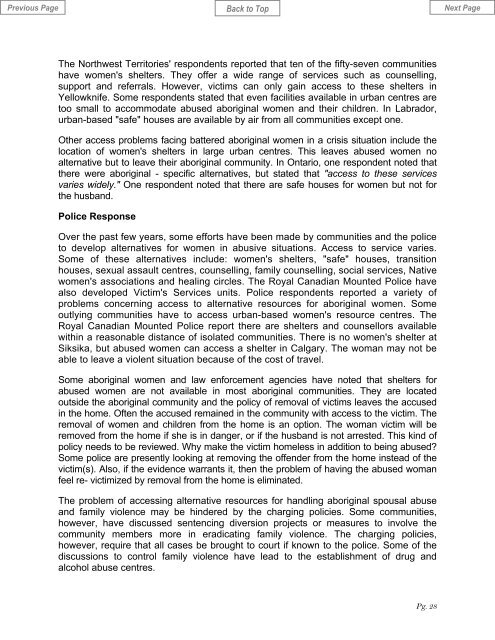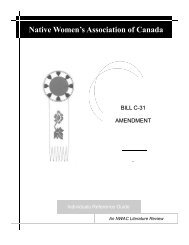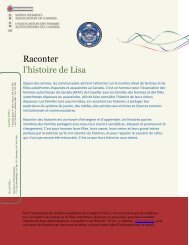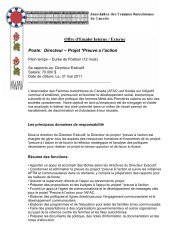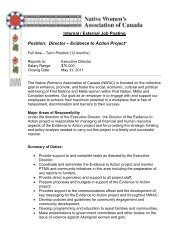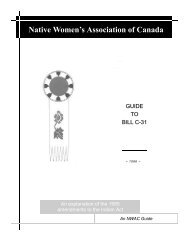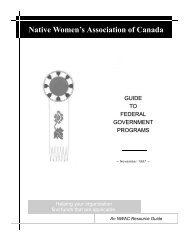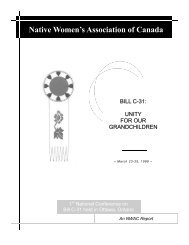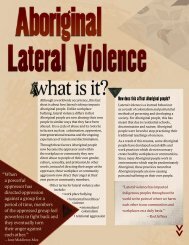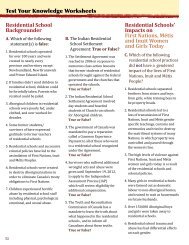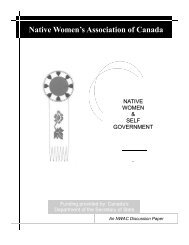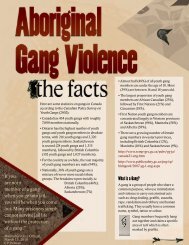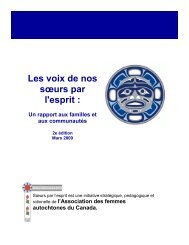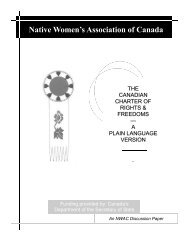POLICE CHARGING POLICIES & DOMESTIC VIOLENCE - Native ...
POLICE CHARGING POLICIES & DOMESTIC VIOLENCE - Native ...
POLICE CHARGING POLICIES & DOMESTIC VIOLENCE - Native ...
- No tags were found...
You also want an ePaper? Increase the reach of your titles
YUMPU automatically turns print PDFs into web optimized ePapers that Google loves.
The Northwest Territories' respondents reported that ten of the fifty-seven communitieshave women's shelters. They offer a wide range of services such as counselling,support and referrals. However, victims can only gain access to these shelters inYellowknife. Some respondents stated that even facilities available in urban centres aretoo small to accommodate abused aboriginal women and their children. In Labrador,urban-based "safe" houses are available by air from all communities except one.Other access problems facing battered aboriginal women in a crisis situation include thelocation of women's shelters in large urban centres. This leaves abused women noalternative but to leave their aboriginal community. In Ontario, one respondent noted thatthere were aboriginal - specific alternatives, but stated that "access to these servicesvaries widely." One respondent noted that there are safe houses for women but not forthe husband.Police ResponseOver the past few years, some efforts have been made by communities and the policeto develop alternatives for women in abusive situations. Access to service varies.Some of these alternatives include: women's shelters, "safe" houses, transitionhouses, sexual assault centres, counselling, family counselling, social services, <strong>Native</strong>women's associations and healing circles. The Royal Canadian Mounted Police havealso developed Victim's Services units. Police respondents reported a variety ofproblems concerning access to alternative resources for aboriginal women. Someoutlying communities have to access urban-based women's resource centres. TheRoyal Canadian Mounted Police report there are shelters and counsellors availablewithin a reasonable distance of isolated communities. There is no women's shelter atSiksika, but abused women can access a shelter in Calgary. The woman may not beable to leave a violent situation because of the cost of travel.Some aboriginal women and law enforcement agencies have noted that shelters forabused women are not available in most aboriginal communities. They are locatedoutside the aboriginal community and the policy of removal of victims leaves the accusedin the home. Often the accused remained in the community with access to the victim. Theremoval of women and children from the home is an option. The woman victim will beremoved from the home if she is in danger, or if the husband is not arrested. This kind ofpolicy needs to be reviewed. Why make the victim homeless in addition to being abused?Some police are presently looking at removing the offender from the home instead of thevictim(s). Also, if the evidence warrants it, then the problem of having the abused womanfeel re- victimized by removal from the home is eliminated.The problem of accessing alternative resources for handling aboriginal spousal abuseand family violence may be hindered by the charging policies. Some communities,however, have discussed sentencing diversion projects or measures to involve thecommunity members more in eradicating family violence. The charging policies,however, require that all cases be brought to court if known to the police. Some of thediscussions to control family violence have lead to the establishment of drug andalcohol abuse centres.Pg. 28


